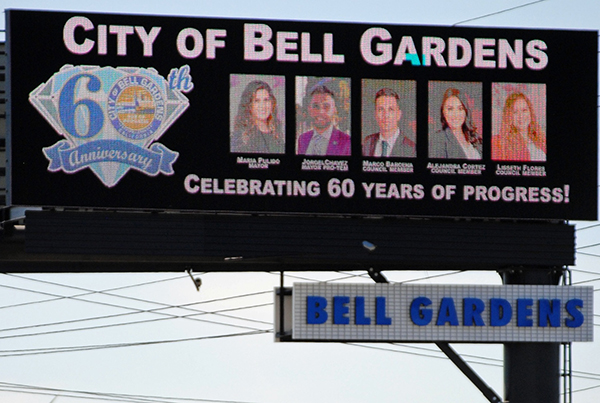By Alfredo Santana
Contributing Writer
BELL GARDENS — The City Council has approved changes proposed by its Planning Commission to issue permits for marketing companies to install electronic billboards within 150 feet of households, only if lights do not impact residents.
Council members reviewed and amended a law approved in 2018 that permitted two digital billboards within the city’s electronic billboard overlay district near the Long Beach (710) Freeway and Florence Avenue, near two parking lots that are the property of the Bicycle Casino.
Council members Marco Barcena, Jorge Chavez, Lisette Flores and Maria Pulido voted for the new ordinance, with Councilwoman Alejandra Cortez absent.
The resolution approved by the Planning Commission concluded the ordinance would not present any risk to the public health and safety.
“Electronic billboards shall be placed at least 150 feet from any residential zone or residential use,” the resolution said. “The measurement shall be from the closest edge of the billboard to the nearest residential zone or boundary line of property on which a residential use is located.”
Digital billboards could provide revenue to the city coffers. In 2018, the city signed a $140,000 a year lease with Outfront Media for two digital screens in place of traditional billboards supported by a metal pillar in an unused patch of Clara Street.
The state Department of Transportation had to issue a special permit, and the initial ordinance was modified in 2019 to add language addressing a structural encroachment into a public right of way within a commercial and manufacturing development zone.
The city will earn similar yearly rent until the five-year agreement expires in 2023.
A clause allows renewal at a new yearly lease of $154,000 from years six to 10.
If both parties decide to extend the agreement, the city would make $165,000 a year for years 11 to 15, and $185,000 each for years 16 to 20.
Before the deal was sealed, Caltrans chimed in with additional concerns. The agency had to relocate an old billboard before it issued installation permits, while the city reported that two static structures were removed.
In the November 2019 amended ordinance, the City Council argued that “the proposed electronic billboard, in addition to its aesthetic treatment, provides public benefits that would not otherwise accrue to the public in the absence of its installation.”
Mostly used for commercial ads, electronic billboards often carry public announcements and advertise services provided by cities and messages from county and other government agencies.
“Billboards companies are increasingly constructing electronic billboards instead of non-electric billboards due to the increased number of advertisers that can be accommodated at one time on a single electronic billboard,” City Manager Michael B. O’Kelly said.
The impact of light-emitting diode, or LED billboards on the environment, road safety and aesthetics are topics of debate.
Some stakeholders argue that they stand out at night, generate more heat in urban surfaces already covered with asphalt and cement, and are sources of additional distractions, particularly to younger drivers.
A 2018 Caltrans analysis on driving behavior titled Outdoor Advertising Report: Changeable Message Sings, said that drivers were “more likely to gaze at electronic billboards than at standard ones.
The analysis included two comparative studies conducted out of state, underscoring that average fixation was similar to digital billboards and static advertisements with “no long single fixations evident for either condition.”
For the study, Caltrans measured the frequency of LED’s billboards ads change at 8 to 10 seconds plus their brightness. The study focused on objects 1,000 feet or less from the drivers.
In summary, Caltrans said that drivers sometimes looked at billboards regardless of their shape or technological prowess when present, but they do not distract overall attention from the roadway ahead.
O’Kelly said cities can enter contracts with billboard owners and be compensated for land usage only if they get in return the right to build video billboards on public properties.
Owners of traditional billboards can also agree to voluntarily remove their settings and obtain permits to construct digital boards in designated locations near a freeway, he said.
For Bell Gardens resident Rafael Silva, allowing electronic billboards on commercial drags near households would not worsen climate change or turn streets into marketing eyesores.
He argued that companies willing to support the city should have public spaces to pitch their goods and services so residents can learn what is available.
“I think the [digital] ads would be OK,” Silva added. “When it comes to warming, cars and trucks contribute much more to climate change and they do not ban them. We have many vehicles running belching smog.”
Sellers on Ebay offer commercial outdoor LED screens of different sizes from $15,900 to $125,900.












